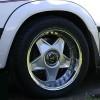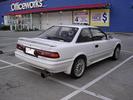| Author | Topic |
|---|

Location:
Canberra
Registered:
August 2003
|
|
Physics problem.
|
 Thu, 24 March 2005 03:43
Thu, 24 March 2005 03:43

|
 |
Do 2 cars colliding each travelling at 50Km/H have the same force as 1 car hitting a wall at 100Km/H??
Only after answers with proof! Need to win an argument and i don't have my text books handy...
|
|
|

Location:
Campbelltown
Registered:
November 2003
|
|
Re: Physics problem.
|
 Thu, 24 March 2005 03:46
Thu, 24 March 2005 03:46
 
|
 |
|
trick question technically they have no force cos they are not accelerating, other variables ie mass need to be taken into account to F=ma
|
|
|

Location:
Canberra
Registered:
August 2003
|
|
Re: Physics problem.
|
 Thu, 24 March 2005 03:50
Thu, 24 March 2005 03:50
 
|
 |
|
If there is no force/acceleration then why does car hitting wall stop?
|
|
|

Location:
Campbelltown
Registered:
November 2003
|
|
Re: Physics problem.
|
 Thu, 24 March 2005 03:50
Thu, 24 March 2005 03:50
 
|
 |
|
and even deceleration cannot be calcualted as you don't know how long it takes, in this case i'd say the brick wall would be more as it would stop you faster than another car as there is only one crumple zone instead of two ,thus the rate of deceleration is greater multiplied by the weight would mean a greater force
|
|
|

Location:
Brisbane
Registered:
May 2002
|
|
Re: Physics problem.
|
 Thu, 24 March 2005 03:51
Thu, 24 March 2005 03:51
 
|
 |
So when a car hits a solid object there are no accelerational forces involved huh?
Hint: 100km/h to 0km/h is a fairly significant change in velocity. Another word for a change in velocity is ________
As for the original question, if two cars travelling at 50km/h collide head-on the impact will be the same as one car travelling at 50km/h hitting a solid object (eg concrete wall). In other words, hitting another car at the same speed is the same as hitting a solid object.
Note we're making quite a few assumptions here, eg cars are the same mass and are travelling on exactly the same plane.
|
|
|

Location:
Canberra
Registered:
August 2003
|
|
Re: Physics problem.
|
 Thu, 24 March 2005 03:58
Thu, 24 March 2005 03:58
 
|
 |
Simple problem guys... think as if it is a high school physics question. ie no crumple zones etc.
Norbie - not sure I agree... Throw some equations behind your thinking?
|
|
|

Location:
Melbourne
Registered:
March 2003
|
|
Re: Physics problem.
|
 Thu, 24 March 2005 04:25
Thu, 24 March 2005 04:25
 
|
 |
two cars hitting at 50kmh is = to one car hitting a stationary car going at 100kmh.
the forces for hitting a wall are different because the mass is diferent
|
|
|

Location:
Blue Mountains
Registered:
December 2004
|
|
Re: Physics problem.
|
 Thu, 24 March 2005 04:28
Thu, 24 March 2005 04:28
 
|
 |
| Norbie wrote on Thu, 24 March 2005 14:51 |
As for the original question, if two cars travelling at 50km/h collide head-on the impact will be the same as one car travelling at 50km/h hitting a solid object (eg concrete wall). In other words, hitting another car at the same speed is the same as hitting a solid object.
|
I disagree, think about it if one car is travelling at 50kms and another is approaching it at 50kms the distance between them is decreasing by 100kms therefore their velocity relative to one another will be 100kms. If a car is travelling at 100kms towards a stationery wall its velocity relative to the wall is 100kms so yes it would be the same. For confirmation see Margaret Wertheim's "Pearly Gates of Cyberspace" page 169.
|
|
|

Location:
Campbelltown
Registered:
November 2003
|
|
Re: Physics problem.
|
 Thu, 24 March 2005 04:31
Thu, 24 March 2005 04:31
 
|
 |
|
but inreality the car hitting the wall will decelerate faster than the other thus it has a greater force.
|
|
|

Location:
Sydney
Registered:
February 2003
|
|
Re: Physics problem.
|
 Thu, 24 March 2005 04:32
Thu, 24 March 2005 04:32
 
|
 |
| Indi wrote on Thu, 24 March 2005 15:28 |
| Norbie wrote on Thu, 24 March 2005 14:51 |
As for the original question, if two cars travelling at 50km/h collide head-on the impact will be the same as one car travelling at 50km/h hitting a solid object (eg concrete wall). In other words, hitting another car at the same speed is the same as hitting a solid object.
|
I disagree, think about it if one car is travelling at 50kms and another is approaching it at 50kms the distance between them is decreasing by 100kms therefore their velocity relative to one another will be 100kms. If a car is travelling at 100kms towards a stationery wall its velocity relative to the wall is 100kms so yes it would be the same. For confirmation see Margaret Wertheim's "Pearly Gates of Cyberspace" page 169.
|
i concur!
|
|
|

Location:
Melbourne
Registered:
December 2004
|
|
Re: Physics problem.
|
 Thu, 24 March 2005 04:32
Thu, 24 March 2005 04:32
 
|
 |
assuming the cars are the same and all that and the wall is really solid then i'd say the wall would be worse to hit because the force involved would occur over a shorter period of time.
2 cars having crumple zones and all that would increase the time of the accident and reduce the forces invloved per unit time
unless... THERE IS NO SPOON 
|
|
|

Location:
Canberra
Registered:
August 2003
|
|
Re: Physics problem.
|
 Thu, 24 March 2005 04:34
Thu, 24 March 2005 04:34
 
|
 |
OK im an Engineer (computer engineer, don't panic) so my definition of proof would involve equations. 
I feel rather stupid I should know this of the top of my head...
|
|
|

Location:
Blue Mountains
Registered:
December 2004
|
|
Re: Physics problem.
|
 Thu, 24 March 2005 04:42
Thu, 24 March 2005 04:42
 
|
 |
| Squid wrote on Thu, 24 March 2005 15:34 |
OK im an Engineer (computer engineer, don't panic) so my definition of proof would involve equations. 
|
How about 50 + 50 = 100? 
|
|
|

Location:
Brisbane
Registered:
May 2004
|
|
|

Location:
Brisbane
Registered:
May 2004
|
|
|

Location:
Tassie
Registered:
October 2003
|
|
Re: Physics problem.
|
 Thu, 24 March 2005 04:58
Thu, 24 March 2005 04:58
 
|
 |
I'm assuming that the cars are just cruising not accelerating.
I've had the same question and had the same arguments
i'm pretty sure they are the same
same forces involved.
same amount of power etc.
|
|
|

Location:
Adelaide
Registered:
September 2003
|
|
Re: Physics problem.
|
 Thu, 24 March 2005 05:08
Thu, 24 March 2005 05:08
 
|
 |
If the cars are travelling at a steady state (i.e. not accelarating prior to the impact, you have to look at the Potential energy of the cars;
PE = 0.5*m*V^2
Since the v^2 term has an effect, the total PE of each car doing 50 does not equal the same as one car doing 100, but there is quite a lot more to it than that.
Have a nice weekend.
How about someone do a practical test of the theory ....
|
|
|

Location:
Brisbane
Registered:
February 2004
|
|
Re: Physics problem.
|
 Thu, 24 March 2005 05:34
Thu, 24 March 2005 05:34
 
|
 |
IT would have to depend how solid the wall is, because a car travelling at 100kmh would break thru a house with ease.
on the other hand if the wall is indestructible, there would be more of an impact with the 100kmh car hitting the wall because there is no play in the wall at all.
|
|
|

Location:
Brisbane
Registered:
May 2002
|
|
Re: Physics problem.
|
 Thu, 24 March 2005 05:39
Thu, 24 March 2005 05:39
 
|
 |
I can't recall any of the equations from high-school physics (which was, depressingly, well over 10 years ago), but I see it like this: the colliding cars are going to come to a complete rest after the collision, assuming both have the same mass and velocity. Similarly, an identical car travelling at the same speed will come to a complete rest after hitting a concrete wall. How are those two situations any different from the perspective of a single driver? In both cases the car accelerates from 50km/h to 0km/h in approximately the same amount of time (allowing for the car to crumple etc), so as far as I can see the forces acting on the car will be the same. It doesn't make sense to add the velocity of car A to car B, they're separate entities.
The example hyperlinked above is interesting but different because it's talking about a collision with a stationary car, not an immovable object like a wall; this makes the characteristics of the collision very different.
|
|
|

Club Member
Location:
sydney
Registered:
May 2002
|
|
Re: Physics problem.
|
 Thu, 24 March 2005 05:39
Thu, 24 March 2005 05:39
 
|
 |
ok ill bite with PE seeing as in my opinion, that is the resultant you are really measuring. speed is just a part of the equation, at constant speed acceleration isnt an issue so all that is left is the potential energy of the two masses so lets do the math...
ill assume that bbaacchhyy's equation is correct despite my instincts as an engineer ( telco ) tell me to never trust anything that i havent seen and refrenced myself.
sooooo...
PE= 0.5 x mass x velocity^2
so lets take the first scenario of two cars traveling at 50kmh towards each other and assume they both weight 1000kg
PE= 0.5 x 1000 x 50^2 x 2
PE= 500 x 2500 x 2
PE= 1.25M x 2
PE= 2.5Mj of energy
scenario 2 the same car of 1000kg travelling at 100kmh to a stationary object that weighs 1000kg
PE= (0.5 x 1000 x 100^2) + (0.5 x 1000 x 0^2)
PE= (500 x 10000) + (500 x 0)
PE= 5Mj + 0j
PE= 5Mj of energy
im fairly confident those calcs are correct, maybe someone needs to double check, the only discretion may be the way the mass of the wall is calculated.
|
|
|

Location:
Coffs Harbour, NSW
Registered:
November 2004
|
|
Re: Physics problem.
|
 Thu, 24 March 2005 05:57
Thu, 24 March 2005 05:57
 
|
 |
ok, where to start...
right, so, if you cut it down to the basics, the impact of two exactly the same cars travelling in exactly opposite directions at 50km/h would be the same as if one car hit a solid wall at 100km/h.
but, of course, the wall is not the same as a car. the cars are made of easily shape changing metal (or plastic)
| Quote: |
As for the original question, if two cars travelling at 50km/h collide head-on the impact will be the same as one car travelling at 50km/h hitting a solid object (eg concrete wall). In other words, hitting another car at the same speed is the same as hitting a solid object.
|
this is definetely incorrect, have a think about the relative speeds involved for the cars: to car 1, car 2 is travelling at 100km/h
| Quote: |
Potential energy of the cars;
PE = 0.5*m*V^2
|
i belive you mean kinetic energy, KE, here?
KE = 1/2m.v^2
PE = m.g.h
to solve this problem, we need to consider the velocity of one car relative to the other. by using vectors (i cant draw them here), we can conclude that car 2 is travelling at 100km/h relative to car 1, and vice versa. note that this is assuming they are travelling at exactly the same velocity (50km/h, opposite direction), ignoring air resistance, and that they are exactly the same car, with the same weight, and no acceleration until the moment of impact (no acceleration or deceleration or change of direction)
assuming the mass of each car is, say, 1000kg, both car's initial velocity is 14m/s (50km/h = 13.9m/s) in opposite directions, the final velocity is 0m/s for both cars, and the time taken for the whole process is 0.5s, we can use newton's 2nd law to find the force exerted on each car:
F = (m.v - m.u)/t
= (1000x14 - 1000x0)/0.5
= 14000/0.5
= 28000 N
for the impact with the wall (assuming it will not move at all), however, the time will be much less, due to the fact that only the car has collapsible parts, where the wall does not, whereas in the collision between two cars, both objects are able to change shape. therefore, we will assume the time for the collision with the wall to be 0.1s. so the force on the car:
F = (m.v - m.u)/t
= (1000x14 - 1000x0)/0.1
= 14000/0.1
= 140000 N
as you can see, the force for the impact with the concrete wall would be much higher than for a collision between two cars
jeez, that would have to be my longest post ever! i hope to never have to do it again 
[Updated on: Thu, 24 March 2005 06:29]
|
|
|

Location:
Melbourne
Registered:
December 2004
|
|
Re: Physics problem.
|
 Thu, 24 March 2005 05:58
Thu, 24 March 2005 05:58
 
|
 |
there's more to it if the other car you hit head on it really solid and heavy.
in that case the wall may be the better option to hit
|
|
|

Club Member
Location:
sydney
Registered:
May 2002
|
|
|

Club Member
Location:
sydney
Registered:
May 2002
|
|
Re: Physics problem.
|
 Thu, 24 March 2005 06:07
Thu, 24 March 2005 06:07
 
|
 |
ok well maybe it wasnt so wrong seeing as this equation for Kenetic energy happens to be the same as the PE one 

|
|
|

Location:
Sydney
Registered:
January 2003
|
|
Re: Physics problem.
|
 Thu, 24 March 2005 06:30
Thu, 24 March 2005 06:30
 
|
 |
Two cars colliding while travelling at 50km/h in opposite directions IS NOT the same as hitting a wall at 100km/h
The main thing to remember when doing calculations with the two cars is that one car is doing +50km/h , the other one is doing -50km/h. This therfore means that if you add the velocities, you get 0.
so.... hitting a brick wall at 50km/h will be the same as hitting a (identical) car travelling in the opposite direction, going 50km'h.
common sense also shows this... you are going from 50km/h to 0km/h in a set time, being the time taken for the crumple zone to well... crumple. this is regardless of what you hit. if you hit another car, the other cars crumple zone doesn't "really" affect your cars, as it has its own car to take care of.
if you hit something with a greater mass or velocity then its a different story, as you will most likely be going backwards after the collision
Richard
|
|
|

Location:
Adelaide
Registered:
September 2003
|
|
Re: Physics problem.
|
 Thu, 24 March 2005 06:33
Thu, 24 March 2005 06:33
 
|
 |
I cant remember much of yr12 physics but isnt there an equation which considers collision time?
In basic theory simple vector addition tells us its the same. .
|
|
|

Location:
Coffs Harbour, NSW
Registered:
November 2004
|
|
Re: Physics problem.
|
 Thu, 24 March 2005 06:33
Thu, 24 March 2005 06:33
 
|
 |
oops, sorry guys, i must of accidently posted the half finished, uh, essay 
so please refer to my previous post, as it has been updated 
|
|
|

Location:
South Australia
Registered:
July 2002
|
|
|

Location:
Coffs Harbour, NSW
Registered:
November 2004
|
|
Re: Physics problem.
|
 Thu, 24 March 2005 06:43
Thu, 24 March 2005 06:43
 
|
 |
| SPRINTAH! wrote on Thu, 24 March 2005 17:30 |
The main thing to remember when doing calculations with the two cars is that one car is doing +50km/h , the other one is doing -50km/h. This therfore means that if you add the velocities, you get 0.
so.... hitting a brick wall at 50km/h will be the same as hitting a (identical) car travelling in the opposite direction, going 50km'h.
common sense also shows this... you are going from 50km/h to 0km/h in a set time, being the time taken for the crumple zone to well... crumple. this is regardless of what you hit. if you hit another car, the other cars crumple zone doesn't "really" affect your cars, as it has its own car to take care of.
|
no, no, no
if you do actually use common sense, you will find that, firstly, hitting a stationary car (assuming it is the same as yours) at 50km/h will do much less damage than colliding with the same car, where you are both doing 50km/h, and secondly, another car's crumple zone will actually affect the force exerted on you, as the object you're hitting will absorb some of the energy into crumpling the metal
man, this stuff is all so obvious to me, i cant see how some of you guys are getting it so wrong! 
|
|
|

Location:
South Australia
Registered:
July 2002
|
|
Re: Physics problem.
|
 Thu, 24 March 2005 06:49
Thu, 24 March 2005 06:49
 
|
 |
|
I'm assuming by 'brick wall' that the brick wall isn't going to absorb any energy of the impact. Of course, any brick wall will absorb some, but this is hypothetical.
|
|
|

Location:
Coffs Harbour, NSW
Registered:
November 2004
|
|
Re: Physics problem.
|
 Thu, 24 March 2005 06:54
Thu, 24 March 2005 06:54
 
|
 |
| FWDboy wrote on Thu, 24 March 2005 17:42 |
People always seem to forget that when two cars collide the energy of the collision is spread between BOTH vehicles rather than just being absored by the one vehicle while the other vehicle is oblivious to what goes on. So in answer to your question, hitting another car at 50km/h when the other car is going 50km/h towards you is about the same as you hitting a wall at 50km/h - in regards to the ENERGY of the impact (edit)that you experience(/edit). Overall the forces involved (for one car) are the same, the big difference is the impulse of the collision, one will dissipate the energy over time (a smaller force over a longer period) and the other will result in a larger force being exerted on your body in a shorter period of time. The same energy is transferred to your body, and the amount of force your body experiences should be the same, it's just that there is more destructiveness in large impulse forces.
|
THANKYOU
hang on, dont you mean hitting another car also travelling 50km/h is the same as hitting a wall at 100km/h?
|
|
|

Location:
South Australia
Registered:
July 2002
|
|
Re: Physics problem.
|
 Thu, 24 March 2005 07:20
Thu, 24 March 2005 07:20
 
|
 |
Depends on your perspective. If you are standing outside and watching the collision occur then you will see two cars collide and stop from 50km/h. Using ye old KE = (0.5)mv^2 then you can see that if both cars are travelling at 50km/h and weigh the same then the energy of the impact is simply 2 * the energy of one car stopping from 50km/h - so an outsider would think.
However if one car from 100km/h stops then the energy is FOUR times the energy of one car stopping from 50km/h. Or so an outsider would think.
Now - if you are INSIDE one of the cars, and you stop from 50km/h to 0km/h then only difference between hitting another car travelling in the opposite direction and hitting a brick wall (from the same speed) is the *peak* force your body experiences. Energy transfer wise both collisions are the same, measuring the forces is a little bit of a pain because it changes so erratically as different things absorb the energy and transform the energy in different ways and the deceleration is rarely consistent.
The force experienced in the collision is hugely dependent on the deceleration rate and how smooth the deceleration vs. time curve is (ie how close (delta)a is to zero at any given time during the collision).
The energy of the collision is REALLY easy to work out, but the force experienced is VERY hard so to compare the two collisions based on their forces - I would MUCH MUCH MUCH rather be in a car hitting another car going 50km/h towards me (going 50km/h) than hitting a brick wall at even 70.7km/h (an equivalent energy collision).
|
|
|

Location:
Coffs Harbour, NSW
Registered:
November 2004
|
|
Re: Physics problem.
|
 Thu, 24 March 2005 07:44
Thu, 24 March 2005 07:44
 
|
 |
| FWDboy wrote on Thu, 24 March 2005 18:20 |
Now - if you are INSIDE one of the cars, and you stop from 50km/h to 0km/h then only difference between hitting another car travelling in the opposite direction and hitting a brick wall (from the same speed) is the *peak* force your body experiences.
|
but we're talking about two cars at 50km/h each and car at 100km/h vs wall
to answer the original question:
basically, if the cars and wall were all equal solid objects, then the force experienced by each object would be the same
|
|
|

Location:
Sydney
Registered:
January 2003
|
|
Re: Physics problem.
|
 Thu, 24 March 2005 07:47
Thu, 24 March 2005 07:47
 
|
 |
skellator wrote on Thu, 24 March 2005 17:43
no, no, no
if you [b |
do[/b] actually use common sense, you will find that, firstly, hitting a stationary car (assuming it is the same as yours) at 50km/h will do much less damage than colliding with the same car, where you are both doing 50km/h, and secondly, another car's crumple zone will actually affect the force exerted on you, as the object you're hitting will absorb some of the energy into crumpling the metal
man, this stuff is all so obvious to me, i cant see how some of you guys are getting it so wrong! 
|
What does hitting a stationary car have to do with anything???
Of course the "damage" will be less when hitting a stationary car, you will be pushing the other car along, coming to a steady stop.
When you hit another car, yes, there is crumpling of metal, but the forces exerted on each car are the same as hitting a wall. whether the forces between the two cars interact or not is rather irrelevant because the net force will always be same.
One car hits a wall with X amount of energy, most of this energy goes into crumpling Y amount of metal,
TWO CARS: each car has X amount of energy, making the ttotal energy 2X, this energy crumples 2Y amount of Metal (seeing as there are 2 cars). making this the same as the single car scenario.
twice the energy, twice the metal.
it would seem that it may not be obvious to you
|
|
|

Club Member
Location:
sydney
Registered:
May 2002
|
|
Re: Physics problem.
|
 Thu, 24 March 2005 08:13
Thu, 24 March 2005 08:13
 
|
 |
| Quote: |
Two cars colliding while travelling at 50km/h in opposite directions IS NOT the same as hitting a wall at 100km/h
|
I never said it was, all i did is work out the potential or kinetic mechanical energy of each object in relation to its velocity and mass. I did not concur a conclusion to the question.
But by knowing the energy each mass has you can forsee what the maximum energy transfer is, the energy transfer will be in forms of decelerating mass, heat, transfer of KE and then you need to start calculating transfer of inertia in the case of two vehicles colliding and then spinning off at angles during energy transfer after impact.
To be honest i dont have the engineering knowledge to calculate the after effect. all i did was give a theoretical calculation as to which has the most energy and from there you can draw your own conlclusions.
my unprofessional diagnosis would be, that which ever event held the most stored energy would be the the one that has the greater energy transfer and by the calculations I can show that the energy transfer is not an equal force between the two theoretical events
|
|
|

I supported Toymods
Location:
Australia
Registered:
November 2003
|
|
Re: Physics problem.
|
 Thu, 24 March 2005 08:39
Thu, 24 March 2005 08:39
 
|
 |

|
|
|

Location:
Coffs Harbour, NSW
Registered:
November 2004
|
|
Re: Physics problem.
|
 Thu, 24 March 2005 08:57
Thu, 24 March 2005 08:57
 
|
 |
| Quote: |
What does hitting a stationary car have to do with anything???
Of course the "damage" will be less when hitting a stationary car, you will be pushing the other car along, coming to a steady stop.
|
ah, sorry, i thought you said hitting a car at 50km/h, but you actually said a brick wall. but in that less damage bit, i was assuming the car would stay put and not crumple, much like the brick wall...hmmm...
anyway, this is the way i like to put it:
a car travelling towards a concrete wall at 100km/h has a velocity, relative to the wall, of 100km/h
a car travelling towards another car, both doing 50km/h, also has a velocity, relative to the other car, of 100km/h
think about it, if you're standing next to a 50km/h road, you see cars go past at a certain, apparent speed
if you're driving along a 50km/h road (at 50km/h, of course, cos you're a sensible driver), you see other cars going the other way at what seems to be a faster speed than when you watched them from a stationary position
btw, cruzsida, put it this way, if two cars collided, both travelling 50km/h, would it cause the same amount of collective damage as if one car hit a concrete wall at 100km/h?
edit: squid, do you want to have a say in this at all? i mean it is your thread 
[Updated on: Thu, 24 March 2005 08:59]
|
|
|

I supported Toymods
Location:
Australia
Registered:
November 2003
|
|
Re: Physics problem.
|
 Thu, 24 March 2005 08:59
Thu, 24 March 2005 08:59
 
|
 |
|
I know exactly what you guys are talking about, I just felt like posting that picture, coz it fits in so well.
|
|
|
Location:
Woolgoolga
Registered:
April 2004
|
|
Re: Physics problem.
|
 Thu, 24 March 2005 09:51
Thu, 24 March 2005 09:51
 
|
 |
|
At this point in time I would like to remind everyone that skellator is gay and does not know what he is talking about.
|
|
|

Location:
Coffs Harbour, NSW
Registered:
November 2004
|
|
|

Location:
Rockhampton QLD
Registered:
July 2004
|
|
Re: Physics problem.
|
 Thu, 24 March 2005 12:22
Thu, 24 March 2005 12:22
 
|
 |
hi, i havent bothered to read all of what has been written but i'll post what i think  . .
two identical, indestructable cars(objects) hitting each other (ignoring crumple zones and crap) at 50km an hour will exert the same force on each other as one car hitting a wall at 50km/h. the wall exerts an equal and opposite force on the car therefore is equivelant to a car doing 50 in the opposite direction. if the car is doing 100km/h and hit a wall it will have twice the force as it would doing 50. simple
thank you
|
|
|

Location:
Rockhampton QLD
Registered:
July 2004
|
|
Re: Physics problem.
|
 Thu, 24 March 2005 12:27
Thu, 24 March 2005 12:27
 
|
 |
| Norbie wrote on Thu, 24 March 2005 13:51 |
So when a car hits a solid object there are no accelerational forces involved huh?
Hint: 100km/h to 0km/h is a fairly significant change in velocity. Another word for a change in velocity is ________
As for the original question, if two cars travelling at 50km/h collide head-on the impact will be the same as one car travelling at 50km/h hitting a solid object (eg concrete wall). In other words, hitting another car at the same speed is the same as hitting a solid object.
Note we're making quite a few assumptions here, eg cars are the same mass and are travelling on exactly the same plane.
|
ah! it's already beeen said, norbies' a genius, the others are jokers 
|
|
|

Location:
South Australia
Registered:
July 2002
|
|
Re: Physics problem.
|
 Thu, 24 March 2005 13:42
Thu, 24 March 2005 13:42
 
|
 |
| skellator wrote on Thu, 24 March 2005 18:14 |
| FWDboy wrote on Thu, 24 March 2005 18:20 |
Now - if you are INSIDE one of the cars, and you stop from 50km/h to 0km/h then only difference between hitting another car travelling in the opposite direction and hitting a brick wall (from the same speed) is the *peak* force your body experiences.
|
but we're talking about two cars at 50km/h each and car at 100km/h vs wall
to answer the original question:
basically, if the cars and wall were all equal solid objects, then the force experienced by each object would be the same
|
You are still missing my point! No wonder people struggle with the theory of relativity.
A 100km/h impact taken by ONE car hitting a wall is a collision with 4 times the energy of a collision of ONE car hitting a wall at 50km/h. The total energy in a TWO 50km/h car collision is TWO times that of a ONE 50km/h car collision - however each car only gets HALF the TOTAL energy of the collision thus EACH car absorbs ONE 50km/h collision's worth of energy - so my point is that if you are inside ONE car (and not TWO, which is impossible) then you will experience ONE 50km/h collisions' worth of energy regardless of what you hit.
|
|
|

Location:
Coffs Harbour, NSW
Registered:
November 2004
|
|
Re: Physics problem.
|
 Fri, 25 March 2005 01:42
Fri, 25 March 2005 01:42
 
|
 |
well, im not sure about the energy bit, but i have confirmation from two (out of two) fellow yr12 physics students, so far, that a car in a collision between two (identical) cars travelling 50km/h in opp directions will experience the same deceleration force as one car colliding with a wall at 100km/h
note that the above is assuming that all energy is used to decelerate the cars, and that the wall is immovable and indestructable
i can also get confirmation from my physics teacher on tuesday

|
|
|

I Supported Toymods
Location:
south Melbourne/KL
Registered:
June 2004
|
|
Re: Physics problem.
|
 Fri, 25 March 2005 02:37
Fri, 25 March 2005 02:37
 
|
 |
okok everyone can wait until NEXT weekend for definate answer. i have a friend from church doin crash test for FORD and i will ask him. however im not goin church this sunday so will get it the following sunday.
be patient and wait!!
|
|
|

Location:
Brisbane
Registered:
May 2002
|
|
Re: Physics problem.
|
 Fri, 25 March 2005 07:14
Fri, 25 March 2005 07:14
 
|
 |
| 86DRFT wrote on Thu, 24 March 2005 22:27 |
ah! it's already beeen said, norbies' a genius, the others are jokers 
|
Woohoo, I'm a genius!! 
|
|
|

Location:
South Australia
Registered:
July 2002
|
|
Re: Physics problem.
|
 Fri, 25 March 2005 08:16
Fri, 25 March 2005 08:16
 
|
 |
| skellator wrote on Fri, 25 March 2005 12:12 |
well, im not sure about the energy bit, but i have confirmation from two (out of two) fellow yr12 physics students, so far, that a car in a collision between two (identical) cars travelling 50km/h in opp directions will experience the same deceleration force as one car colliding with a wall at 100km/h
note that the above is assuming that all energy is used to decelerate the cars, and that the wall is immovable and indestructable
i can also get confirmation from my physics teacher on tuesday

|
Well they aren't going to pass Year 12 physics at that rate - sorry to say!
Okay let me break it down for you.
The "total" accelerative force is the zero vector. You just can't add up both forces like they are scalars because the are not. Force is a vector. This is why I'm saying that if you go from 50km/h to 0km/h it doesn't matter what you hit, it's only the RATE that you slow down (or the length of the crash) that counts in regards to FORCE that YOU inside the car experience - it's not about whether something else ALSO slows down, all that matters from INSIDE the car is that you went from 50km/h to 0km/h (and how quickly you did it too).
It doesn't matter whether you hit a truck going 20, a boeing 747 going 600km/h (although I imagine going from 50km/h to 0 is unlikely, more likely you will go from 50km/h to -590km/h) or a massive pile of feathers - all that matters is the TIME frame if you are worried about the FORCE of the collision.
I could go on for hours showing you equations but it's a waste of my time.
If you go from 100km/h to 0km/h in the same time frame then the force you experience will double.
Hitting a wall at 50km/h feels *almost* the same as hitting a car coming at you at 50km/h
END OF STORY.
And tell those physics students FORCE IS A DAMN VECTOR I HATE IT WHEN PEOPLE FUCK THAT UP FOR GOD'S SAKE.
[Updated on: Fri, 25 March 2005 08:22]
|
|
|

Location:
Coffs Harbour, NSW
Registered:
November 2004
|
|
Re: Physics problem.
|
 Fri, 25 March 2005 08:40
Fri, 25 March 2005 08:40
 
|
 |
so you know, im a physics student too, and i easily passed yr 11 physics (which uses this type of stuff more than yr12) using this reasoning, as did they
im not adding forces, im adding velocities
if you hit a stationary object (the wall) at 50km/h, then hit an object moving in the opposite direction to you, also at 50km/h, which do you think will result in more force?
add the velocities:
100km/h of a car + - 0km/h of the wall = 100km/h in your direction
50km/h of your car + - 50km/h of the other car (opposite direction) = 100km/h in your direction
using these figures, force is (approximately) the same (change in momentum / time)
btw, dont worry, you're not the only one who's getting frustrated with other's ignorance...
|
|
|

Location:
South Australia
Registered:
July 2002
|
|
Re: Physics problem.
|
 Fri, 25 March 2005 09:10
Fri, 25 March 2005 09:10
 
|
 |
| skellator wrote on Fri, 25 March 2005 19:10 |
so you know, im a physics student too, and i easily passed yr 11 physics (which uses this type of stuff more than yr12) using this reasoning, as did they
im not adding forces, im adding velocities
if you hit a stationary object (the wall) at 50km/h, then hit an object moving in the opposite direction to you, also at 50km/h, which do you think will result in more force?
add the velocities:
100km/h of a car + - 0km/h of the wall = 100km/h in your direction
50km/h of your car + - 50km/h of the other car (opposite direction) = 100km/h in your direction
using these figures, force is (approximately) the same (change in momentum / time)
btw, dont worry, you're not the only one who's getting frustrated with other's ignorance...
|
Velocity is a vectors too.... and 50 + -50 = 0 .... not 100!!!
Take a step back from the problem, think about it and work on it and you'll get there. There is no need to state where you are at in your education because it's not pertinent to the problem at hand - a pass in year 11 physics just means you did some tests, it doesn't change your argument 
|
|
|

Location:
Coffs Harbour, NSW
Registered:
November 2004
|
|
Re: Physics problem.
|
 Fri, 25 March 2005 09:22
Fri, 25 March 2005 09:22
 
|
 |
| FWDboy wrote on Fri, 25 March 2005 20:10 |
| skellator wrote on Fri, 25 March 2005 19:10 |
50km/h of your car + - 50km/h of the other car (opposite direction) = 100km/h in your direction
|
Velocity is a vectors too.... and 50 + -50 = 0 .... not 100!!!
|
whoops! i meant, use the formula v1 + - v2
and v2 = -50 (opposite direction)
so v1 + - v2
= 50 + - -50
= 100
there that's better!
but i still cant see why you think like you do 
|
|
|

Location:
South Australia
Registered:
July 2002
|
|
Re: Physics problem.
|
 Fri, 25 March 2005 10:42
Fri, 25 March 2005 10:42
 
|
 |
|
Don't worry about formulas! Just think about it in your head and sort it out - I'm telling you the "formulas" are going to mess you up unless you can back them up with an explanation of what they mean etc and why they are true.
|
|
|
Registered:
March 2005
|
|
Re: Physics problem.
|
 Fri, 25 March 2005 11:45
Fri, 25 March 2005 11:45
 
|
 |
|
Skellator has it right (I think, yr11 was too long ago).
|
|
|
Registered:
March 2005
|
|
Re: Physics problem.
|
 Fri, 25 March 2005 11:49
Fri, 25 March 2005 11:49
 
|
 |
| skellator wrote on Thu, 24 March 2005 21:01 |
ok, well "neigh"s car broke today 
|
And who's car broke not long before that (a couple of times too) 
|
|
|

Location:
South Australia
Registered:
July 2002
|
|
Re: Physics problem.
|
 Fri, 25 March 2005 12:40
Fri, 25 March 2005 12:40
 
|
 |
Alex120 -> Why?
Okay, this is my LAST effort, if you don't get the picture now then you should never EVER become an engineer/scientist/phsyicist/anything.
Picture in your mind a SUPER SUPER slow-mo collision of two identical cars - you are standing on the sidewalk directly looking at where they will impact, one coming from the left, one coming from the right. Focus directly at the point where they collide. Okay freeze frame - the two cars are just touching nose to nose - both are going 50km/h at this point. Press the button for the next frame, the bonnet/bumper is starting to crumple and both cars are slowing down, you can see that the rear of the car is still moving and the cars are squeezing together but the very front part of each car is staying where it is. Next frame, the front of both cars are still static (where they ifirst mpacted) and the car is squashing up, the rear is now moving very slowly - the cars are just crumpling together and the speed has dropped dramatically for both cars - the rears are both moving at bugger all km/h. Finally the come to rest and neither car is crumpling and everything is still.
Okay - you can press normal speed now, the accident is over. Nothing to see here.
Now in your head, replay that accident, but instead of the car of the left, place a brick wall in it's place and picture the same thing, car is moving at 50km/h from the right and watch super slow mo just as it touches the wall, and skip the frames forward - does anything different happen to the one car? Does it crumple differently or slow down any more rapidly? Does the front of the car move any differently, is the rear of the car squashing up faster/slower than it did in the 2 car accident?
DO NOT THINK ABOUT NUMBERS HERE!
|
|
|

Location:
Coffs Harbour, NSW
Registered:
November 2004
|
|
Re: Physics problem.
|
 Fri, 25 March 2005 22:50
Fri, 25 March 2005 22:50
 
|
 |
ok, that way of explaining it is very powerful,but if you think of it this way:
two cars colliding at 50km/h each is just like one car colliding with the wall, also both going 50km/h
so to make up for this in the one car/wall collision, where the wall is stationary, the car needs to be travelling at 100km/h to acheive the same "damage"
and yeah, alex, can you back me up with some explanation please? 
and my car has done about twice the km's of neigh's
|
|
|

Location:
Perth
Registered:
June 2002
|
|
Re: Physics problem.
|
 Sat, 26 March 2005 00:46
Sat, 26 March 2005 00:46
 
|
 |
| skellator wrote on Fri, 25 March 2005 17:22 |
use the formula v1 + - v2
and v2 = -50 (opposite direction)
so v1 + - v2
= 50 + - -50
= 100
|
I was going to piss fart around with my year 12 Physics book but I thought I would just quote this bloke instead.
Ok consider this....
A car traveling at 50km/h and another car traveling at 60km/h. In the same direction.
The cars will collide at 10km/h. You just subtract the 2 away from each other.
Because the cars are traveling in opposite directions you need to add a 'negative' into the formula.
If you are driving at a wall at 50km/h the distance between you and the wall is decreasing by 50km/h.
Now if you are driving at 50km/h, and another car is driving at you at 50km/h, the distance between the cars is decreasing at 100km/h.
This isn't that hard....
|
|
|

Location:
Coffs Harbour, NSW
Registered:
November 2004
|
|
Re: Physics problem.
|
 Sat, 26 March 2005 00:58
Sat, 26 March 2005 00:58
 
|
 |
| gabe wrote on Sat, 26 March 2005 11:46 |
| skellator wrote on Fri, 25 March 2005 17:22 |
use the formula v1 + - v2
and v2 = -50 (opposite direction)
so v1 + - v2
= 50 + - -50
= 100
|
I was going to piss fart around with my year 12 Physics book but I thought I would just quote this bloke instead.
Ok consider this....
A car traveling at 50km/h and another car traveling at 60km/h. In the same direction.
The cars will collide at 10km/h. You just subtract the 2 away from each other.
Because the cars are traveling in opposite directions you need to add a 'negative' into the formula.
If you are driving at a wall at 50km/h the distance between you and the wall is decreasing by 50km/h.
Now if you are driving at 50km/h, and another car is driving at you at 50km/h, the distance between the cars is decreasing at 100km/h.
This isn't that hard....
|
YES! THANKYOU!
finally! someone who understands where im coming from!
that is exactly what i've been trying to say 
|
|
|

Location:
South Australia
Registered:
July 2002
|
|
Re: Physics problem.
|
 Sat, 26 March 2005 01:47
Sat, 26 March 2005 01:47
 
|
 |
| Quote: |
wo cars colliding at 50km/h each is just like one car colliding with the wall, also both going 50km/h
so to make up for this in the one car/wall collision, where the wall is stationary, the car needs to be travelling at 100km/h to acheive the same "damage"
|
I have NO idea what you are trying to say here, be more specific/clear.
We don't seem to be on the same page.
For starters - discussing the *speed* (not VELOCITY) at which the two cars approach each other isn't worth while. Velocity must have a DIRECTION, the rate at which the two cars approach each other is directionless! Please - ditch the numbers and the formulas - you aren't even explaining why they are important or what they have to do with the forces in the accident and who or what experiences those forces.
It is ridiculously obvious that two cars both going 50km/h one travelling from the left and one travelling from the right, will approach each other at a rate of 100km/h. That is not under debate, what is under debate is that if you are inside one of the cars - which accident would appear worse.
Like I said, you have to take into account your PERSPECTIVE on the issue. If you are looking at the collision from an outsiders perspective, the energy involved in the crash where one car comes from the left at 50km/h and another comes from the right at 50km/h is going to be twice as destructive as one car hitting a wall (wall stationary, car 50km/h).
BUT
If you are INSIDE one of the cars, and you are in the accident, the forces you experience either hitting a wall or another car coming at you are almost exactly the same (the fact that a car will crumple ever so slightly differently when smacking into concrete compared to smacking into metal should be taken into consideration).
Also - please remember that the energy of the accident is related to the SQUARE of the velocity and is LINEARLY related to the mass of the object(s).
Thus if you halve the mass of the objects in an accident (ie make it a one car accident), you will have to times the velocity of the object by the square root of 2 to come up with the same kinetic energy. (ie go 70.7km/h into a wall, instead of 50km/h).
And the next person who says 'I wanted to consult my Year 12 physics book' or 'I passed year 11 physics' please be careful with you 'argument'.
|
|
|

Location:
South Australia
Registered:
July 2002
|
|
Re: Physics problem.
|
 Sat, 26 March 2005 01:53
Sat, 26 March 2005 01:53
 
|
 |
|
I'm not sure, but are you saying that if you were about to have a head on accident (both cars going 50km/h) and your only other option would be to mash the throttle, accelerate, and hit a wall at 99km/h - you would go for the wall instead of hitting the car?
|
|
|

Location:
Coffs Harbour, NSW
Registered:
November 2004
|
|
Re: Physics problem.
|
 Sat, 26 March 2005 02:16
Sat, 26 March 2005 02:16
 
|
 |
| Quote: |
I have NO idea what you are trying to say here, be more specific/clear.
|
im saying that hitting an object at 50km/h is the same as hitting an object at 50km/h. but because the wall is stationary, to get the same velocity as the two car collision you would have to be approaching the wall at 100km/h
| Quote: |
We don't seem to be on the same page.
|
actually, im not sure we are. im basically saying that a two car collision would cause as much collective damage as a one car/wall collision
| Quote: |
discussing the *speed* (not VELOCITY) at which the two cars approach each other isn't worth while. Velocity must have a DIRECTION, the rate at which the two cars approach each other is directionless!
|
i am discussing the freakin velocity! that's why there's the negative and positives!
and how does it not have a direction? its just different for each car
| Quote: |
ditch the numbers and the formulas
|
you do realise that you are also trying to explain yourself with numbers and formulas
| Quote: |
It is ridiculously obvious that two cars both going 50km/h one travelling from the left and one travelling from the right, will approach each other at a rate of 100km/h.
|
then how can you argue what you are?!! argh!
| Quote: |
Like I said, you have to take into account your PERSPECTIVE on the issue. If you are looking at the collision from an outsiders perspective, the energy involved in the crash where one car comes from the left at 50km/h and another comes from the right at 50km/h is going to be twice as destructive as one car hitting a wall (wall stationary, car 50km/h).
|
ok, i think we are on different grounds, here, that is exactly what im trying to say...
| Quote: |
If you are INSIDE one of the cars, and you are in the accident, the forces you experience either hitting a wall or another car coming at you are almost exactly the same
|
but i still dont see where you get this from. if the relative velocies are equal, the force would be equal. please tell me you agree with this one...
|
|
|